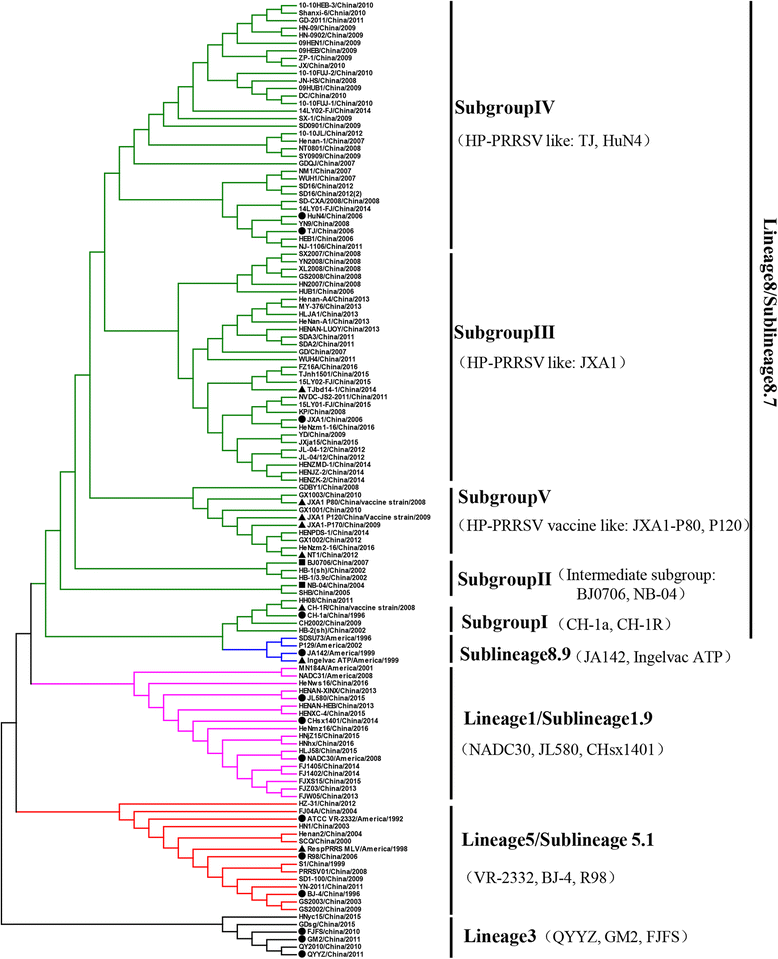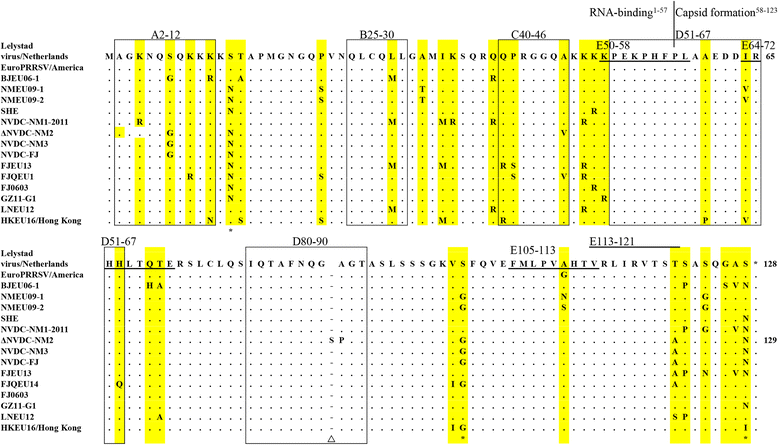The prevalent status and genetic diversity of porcine reproductive and respiratory syndrome virus in China: a molecular epidemiological perspective
- PMID: 29301547
- PMCID: PMC5753475
- DOI: 10.1186/s12985-017-0910-6
The prevalent status and genetic diversity of porcine reproductive and respiratory syndrome virus in China: a molecular epidemiological perspective
Abstract
Porcine reproductive and respiratory syndrome virus (PRRSV) has been epidemic more than 30 years in America and 20 years in China. It is still one of the most important causative agents to the worldwide swine industry. Here, we systematically analyzed the prevalence status of PRRSV in China by a molecular epidemiological perspective. Now both PRRSV-1 and PRRSV-2 are circulating and approximately more than 80% of pig farms are seropositive for PRRSV. For PRRSV-2, there are four lineages (lineage 1, lineage 3, lineage 5, lineage 8) circulating in the fields. Lineage 8 (CH-1a-like) and lineage 5 (BJ-4-like) appeared almost at the same time during 1995-1996. Notably, BJ-4 shares 99.6% and 99.8% identity with VR2332 and RespPRRS MLV, respectively. It means that lineage 5 is likely to be imported from America. Now highly pathogenic PRRSV (HP-PRRSV) which was considered to be evolved from local diversity of lineage 8 strains is predominant with different variants. Lineage 3 appeared in 2010 which is mainly sporadic in south of China. Lineage 1, also known as NADC30-like strains in China, has been prevalent since 2013 and leads to PRRS pandemic again. For PRRSV-1, although sporadic at present, more than 9 provinces/regions have been reported. All the circulating strains belong to subtype I. It should be paid more attention since there are no vaccines available. Our analysis would help to deeply understand the prevalent status of PRRSV in China and provide useful information for prevention and control of porcine reproductive and respiratory syndrome (PRRS).
Keywords: Control strategies; Molecular epidemiology; PRRSV-1; PRRSV-2; Porcine reproductive and respiratory syndrome virus (PRRSV).
Conflict of interest statement
Ethics approval and consent to participate
Not applicable
Consent for publication
Not applicable
Competing interests
The authors declare that they have no competing interests.
Publisher’s Note
Springer Nature remains neutral with regard to jurisdictional claims in published maps and institutional affiliations.
Figures




References
-
- Holtkamp DJ, Kliebenstein JB, Neumann EJ, Zimmerman JJ, Rotto HF, Yoder TK, Wang C, Yeske PE, Mowrer CL, Haley CA. Assessment of the economic impact of porcine reproductive and respiratory syndrome virus on United States pork producers. J Swine Health Prod. 2013;21(2):72–84.
-
- Keffaber KK. Reproductive failure of unknown etiology. Am. Assoc. swine Pract. Newsletter. 1989;1:1–9.
-
- Chang CC, Chung WB, Lin MW, Weng CN, Yang PC, Chiu YT, Chu RM. Porcine reproductive and respiratory syndrome (PRRS) in Taiwan. I. Viral isolation. J Chin Soc Vet Sci. 1993;19(4):268–276.
-
- Baron T, Albina E, Leforban Y, Madec F, Guilmoto H, Plana DJ, Vannier P. Report on the first outbreaks of the porcine reproductive and respiratory syndrome (PRRS) in France. Diagnosis and viral isolation. Ann Rech Vet. 1992;23:161–166. - PubMed
Publication types
MeSH terms
LinkOut - more resources
Full Text Sources
Other Literature Sources
Research Materials
Miscellaneous

